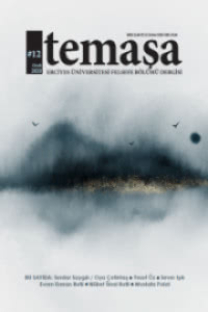Özbilincin Oluşumu ve Tanınma Problemi: Narziss ve Goldmund
Felsefe tarihinde, özbilincin oluşumu ve tanınma sorununa ilişkin en kapsamlı çözümleme ve kavramsallaştırma Tinin Fenomenolojisi adlı eserinde Hegel tarafından yapılmıştır. Makalede, bu konuyla ilgili temel referans olan bu eserin özellikle “Bilinç” ve “Özbilinç” bölümündeki çözümlemelere yönelik yeniden bir okuma denemesi yapılmaktadır. Özbilincin oluşumu ve tanınma sorununa ilişkin felsefi literatürde yapılan çalışmalar genelde bu eserin Özbilinç bölümünde ortaya konulan Efendi-Köle diyalektiğine odaklanmaktalar. Dolayısıyla özbilince ve tanınma sorununa ilişkin diğer yaklaşımlar fazla dikkate alınmaz. Bu nedenle çalışma, Efendi-Köle diyalektiğiyle birlikte özbilince ilişkin farklı değerlendirme ve anlamlandırma olanaklarına dikkat çekmeyi amaçlamaktadır. Bu amaçla, çalışmada öncelikle insanın özbilinç olarak oluşumu, kendini tanıması ve bilmesi üzerinde durulmaktadır. İkinci olarak, iki özbilincin tek taraflı ve eşit olmayan tanınma biçimi olarak Efendi-Köle diyalektiğine değinilmektedir. Son olarak da, özbilincin kendinde ikileşmesi ve özbilinç olarak iki bireyin karşılaşması ve tanınmasının anlamı üzerinde durulmaktadır. Bu anlam, Herman Hesse’nin, örneklem olarak seçilen “Narziss ve Goldmund” romanından hareketle yapılan çözümleme ve değerlendirmelerle daha somut ve anlaşılır kılınmaya çalışılmaktadır.
Anahtar Kelimeler:
Duyusallık, Anlama Yetisi, Akıl, Öz-bilinç, Öteki, Tanınma
Formation of Self-Consciousness and the Problem of Recognition: Narziss and Goldmund
The most complete analys and conceptualisation the problem of the formation and recognition of self-consciousness in the history of philosophy was made by Hegel in his work The Phenomenology of Spirit. This article attempts to re-read the analysis given in the "Consciousness" and "Self-Consciousness" chapter of the mentioned work, which serves as the main reference on this topic. İn the filosophy field literature studies on the problem of formation of self-consciousness and the recognition are usually focused on the Master-Slave dialectic presented in the "Self-Consciousness" chapter of this work. Therefore, little attention is given to other approaches to the problem of self-consciousness and recognition. In this regard, this study aims to draw attention to different possibilities of evaluating and interpreting self-consciousness beside of the Master-Slave dialectic. To achieve this goal, in the study we fırsty examine the process of forming self-consciousness, self-knowledge, and self-recognition. Secondly, we evaluate the master-slave dialectic as a one-sided and unequal recognition of two self-consciousnesses. Finally, we focus on the meaning of the self-consciousness's duality as well as of the encounter and recognition of two individuals as self-consciousness. We are trying to make this meaning more concrete and understandable using the analysis and evaluations given in Hermann Hesse's novel “Narcissus and Goldmund”, which was chosen as an example.
Keywords:
Sensitivity, Understanding, Reason, Self-Consciousness, Other, Recognition,
___
- Bavaresco, Agemir, Andrew Cooper, Andrew James Latham and Thomas Raysmith. “Readings of “Consciousness”: Hegel’s, Phenomenology of Spirit,” Journal of General Philosophy (JPhilo) 1, no: 1 (Marc 2014): 15-26. https://doi.org/10.5176/0000-0001_1.1.3
- Bumin, Tülin. Hegel-Bilinç Problemi, Köle-Efendi Diyalektiği, Praksis Felsefesi. 8. Baskı. İstanbul: Yapı Kredi Yayınları, 2020.
- Bülow, Friedrich. Hegel: Recht, Staat, Geschichte. Stuttgart: Alfred Kröner Verlag, 1955.
- Gadamer, Hans-Georg. “Hegel’in Özbilinç Diyalektiği” Alman İdealizmi, Hegel içinde, Çeviren: Çetin Balanuye, 189-212. Ankara: Doğu Batı Yayınları, 2013.
- Harris, H. S. “Bilinç”, “Özbilinç” Alman İdealizmi, Hegel içinde, Çeviren: Emre Ebetürk, 162-188. Ankara: Doğu Batı Yayınları, 2013.
- Hegel, Georg Wilhelm Friedrich. Tinin Görüngübilimi. Çeviren: Aziz Yardımlı, İstanbul: İdea Yayınları, 2011.
- Hesse, Hermann. Narziss ve Goldmund. Çeviren: Kamuran Şipal, İstanbul: Afa Yayınları, 1991.
- Honneth, Axel. Tanınma Uğruna Mücadele. Çeviren: Özgür Aktok, İstanbul: İthaki Yayınları, 2016.
- Jaeschke, Walter. “The Self-Consciousness of Consciousness” in Translating Hegel The Phenomenology of Spirit And Modern Philosophy, Edited by Brian Manning Delaney&Sven-Olov Wallenstein, 55-70. Södertörn Philosophical Studies, Stockholm 2012. https://www.academia.edu/
- Kojéve, Alexandre. Hegel Felsefesine Giriş. Çeviren: Selahattin Hilav, İstanbul: Yapı Kredi Yayınları, 2000.
- Ludwig, Ralf. Hegel für Anfänger Phänomenologie des Geistes. 9. Auflage. München: dtv Verlagsgesellschaft mbH&Co. KG, 2015.
- Marcuse, Herbert. Us ve Devrim, Hegel ve Toplumsal Kuramın Doğuşu. Çeviren: Aziz Yardımlı, İstanbul: İdea Yayınları, 2000. Pippin, Robert B. “On Hegel’s Claim that Self-Conscious is ‘Desiere Itself’” in Translating Hegel The Phenomenology of Spirit And Modern Philosophy, Edited by Brian Manning Delaney&Sven-Olov Wallenstein, 31-53. Södertörn Philosophical Studies, Stockholm 2012. https://www.academia.edu/ Pöggeler, Otto. “Tinin Fenomenolojisi’ni Anlamlandırma Girişimleri” Alman İdealizmi, Hegel içinde, Çeviren: Aytekin Keskin, 137-161. Ankara: Doğu Batı Yayınları, 2013. Russon, John. “Self and Other in Hegel’s Phenomenology of Spirit,” Journal of Indian Council of Philosophical Research XVIII, no: 4 (Oct-Dec 2011): 1-18. https://www.academia.edu/
- ISSN: 2148-371X
- Yayın Aralığı: Yılda 2 Sayı
- Başlangıç: 2014
- Yayıncı: Prof. Dr. Arslan Topakkaya / Erciyes Üniversitesi Felsefe Bölümü
Sayıdaki Diğer Makaleler
Spinoza’da İnsan Zihninin Ebediliği Üzerine
Geleneksel Eğitim ile Çevrimiçi Eğitimin Felsefi Bağlamda Analizi
Sühreverdî ve Şehrezûrî’de Tenasühe Dair Düşünceler
Mehmet DURAN, Ahmet Kamil CİHAN
Bilinç Bilmecesinin Kısa Bir Analizi
Millianizm, Boş İsimler Ve Önerme-Yok Görüşü
John Rogers Searle’ün “Deontik Güç” Kavramı
Leibniz Felsefesi’nde Akılsal-Olgusal Hakikat Ayrımı
Aziz Murat KARACA, Sedat DOĞAN
Aletik Bağıntılar Işığında Mantık Eklemlerinin Anlamları
Platon’da Ahlak ve Siyaset İlişkisi
İbn Haldûn Düşüncesi ve Liberal Görüşler Arasında Mukayeseli Bir Değerlendirme
